Your personal Tumblr library awaits
Women In Science - Blog Posts

Who was Marjory Stoneman Douglas?
It is Women’s History Month and we would be remiss if we did not discuss one of the most iconic women in the environmental sciences: Marjory Stoneman Douglas. Marjory’s work in conservation was so impactful she was inducted into several halls of fame, awarded the Presidential Medal of Freedom, and has several institutions now named after her. But just what did Marjory do to earn these honors?
Born in 1890, Marjory Stoneman was a suffragette and an environmental advocate. She became a Miami resident in 1915 when there were under 5,000 people there. From there she would dabble in several different careers in The Miami Herald, the Navy, and as a freelance writer. All of these experiences would cumulate to her writing her book: The Everglades:River of Grass. This book was a pivoting point for the way people viewed the Florida Everglades and its importance. The impact of this book is often compared to Rachel Carson’s Silent Spring.
Her research and writing motivated people like never before to not just see the value in the Everglades, but to protect it from impending real estate development. She is part of the reason the Everglades is now a national park. Her work to protect the Everglades and its conservation continued well into her later years until she died at the age of 108 in 1998.
Two South Florida public schools are named in her honor: Broward County Public Schools’ Marjory Stoneman Douglas High School and Miami-Dade County Public Schools’ Marjory Stoneman Douglas Elementary School.
March is Women’s History Month and therefore the perfect time to share the accomplishments of amazing women like Nzambi Matee from Nairobi, Kenya. Nzambi is one of seven winners of The Young Champions of the Earth prize. Announced in December 2020, this United Nations Environment Program initiative engages youth in tackling the world’s most pressing environmental challenges.
Tired of seeing plastic waste littering the streets of Nairobi, Nzambi was determined to make a difference. She developed a mix of sand and plastic that when heated and compressed could produce bricks that are harder than cement. The building applications are enormous but as of the filming of this video she is currently only producing pavers. She hopes to scale the production and expand the use of her bricks.
Plastic waste is an environmental concern the world over. Our reliance on petrochemicals, single use plastics and cheap manufacturing materials has made plastics an increasingly dangerous threat to our biosphere.
You can read more about her work here: Building Blocks for a Greener Nairobi
References:
Roland Geyer, Jenna R. Jambeck and Kara Lavender,’Production, use and fate of all plastics ever made’,(Science Advances 19 Jul 2017: Vol. 3, no. 7, e1700782)
Hayden K. Webb, Jaimys Arnott, Russell J. Crawford and Elena P. Ivanova, ‘Plastic Degradation and Its Environmental Implications with Special Reference to Poly(ethylene terephthalate),’, (Faculty of Life and Social Sciences, Swinburne University of Technology, 28 December 2012)
Importance of Volunteering
If you are a high school student, volunteering is probably a requirement for graduation. Finding an organization to volunteer with can be challenging, especially during a global pandemic. There are a couple of resources that can help you find opportunities. Before we get to those, I want to encourage you to think about your interests and what you hope to get out of your volunteer experience. I also want to encourage you to look beyond fulfilling a graduation requirement. Volunteering provides you with experience that you can list on your resume and if you stay with an organization for a while, it can lead to references and letters of recommendation. I always remind my volunteers to treat their volunteer position like a job. Just because you are not getting paid does not mean you’re not acquiring work experience.
Where to look
Hands on Broward is a database of volunteer opportunities in Broward County and it allows users to search for opportunities based on their interests and location. Volunteer Connect is Volunteer Florida’s opportunity portal. It runs on the same software as Hands on Broward and is another resource I recommend to anyone interested in volunteering.
Different organizations use these platforms in different ways. At the Sawgrass Nature Center and Wildlife Hospital we use Hands on Broward to recruit episodic volunteers. This means that volunteers that sign up for these opportunities are not making a long-term commitment to us. You can volunteer once or multiple times, but you are limited to the dates and times posted.
If there is a specific organization, you are interested in start by visiting their website. Often, organizations will have volunteering information online. Be sure to read the requirements carefully and follow the instructions provided. If you have questions give them a call or send an e-mail if one is provided. Depending on the organization some volunteer opportunities will have age requirements. For example, our volunteer program has two different tracks based on age: Junior Volunteers are aged 13-17 and Adult Volunteers are 18 and older.
How to be a great volunteer
I am fortunate to work with amazing volunteers daily. They show up and do great work every single day. Our most successful volunteers understand our mission and how it relates to their assigned position. It is for this reason that I encourage volunteers to find something that aligns with their interests and goals. Please start your search early so that you are not scrambling to complete your hours with only months left to spare. Due to Covid-19 a lot of volunteer programs are operating at a limited capacity if they are operating at all.
Lastly, use volunteering as an opportunity to practice important skills such as speaking on the phone and writing professional e-mails. If you need to excuse yourself from a shift or need to ask a question it is a good idea to do it yourself rather than rely on an adult to do it for you. I love hearing from my volunteers and I especially like to see students taking an active role in the management of their volunteer role.
Learn more here: https://sawgrassnaturecenter.org/2020/11/17/finding-volunteer-opportunities-for-high-schoolers/

Hey everyone,
The Sawgrass Nature Center is halfway to our minimum goal to provide free educational and professional development resources to Title I schools. These resources will include an environmental education program, a volunteer program, and professional skill building program. The professional skill building program will teach students how to write and build their resume, how to navigate an interview, and how to use social media is changing the job market. The volunteer program will provide them with skill building, hands-on experience at the Sawgrass Nature Center as well as a resume building and networking opportunity. The environmental education program will give them the chance to interact with wildlife and wildlife rehabbers in an educational environment.
To qualify as a Title I school, 40% of the student body must be living below the poverty level. This funding will allow us to bring resources to typically underserved communities to help bridge the gap in job opportunities and educational quality between socio-economically distinguished groups.
Please consider sharing or donating here: https://acommunitythrives.mightycause.com/story/Elzntf
Disclaimer: The SNC is continuing to take every necessary precaution to protect our employees and volunteers from COVID-19, including virtual programming.







Hi! My name is Abby De la Rocha and I am the Volunteer Coordinator at the Sawgrass Nature Center and Wildlife Hospital in Coral Springs, Florida. I was born in Puerto Rico and lived there until my family moved to Botswana when I was 8 years old. I returned to Puerto Rico when I was 16 and finished high school in Ponce. I then moved to New Orleans where I studied at Loyola University. I have been in Florida since 2006.
In this post, I’m going to tell you about Hispanic Heritage month as well as some interesting facts about Puerto Rico’s agriculture and its most precious ecosystem El Yunque.
What is Hispanic Heritage Month?
Each year, we observe National Hispanic Heritage Month from September 15 to October 15 by celebrating the histories, cultures, and contributions of American citizens whose ancestors came from Spain, Mexico, the Caribbean, and Central and South America.
This year’s Hispanic Heritage Month theme- Hispanics: Be Proud of Your Past, Embrace the Future – invites us to embrace our backgrounds, to be proud of who we are and where we came from.
Embracing the Future
The future of agriculture in Puerto Rico
Currently, Puerto Rico imports 85% of its food. This is a huge vulnerability for an island with a population of 3.1 million. For several years, my family has been involved in the agroecological movement which seeks to increase the self-sufficiency of Puerto Rico through their agricultural project Finca El Reverdecer. This movement has been largely spearheaded by young people who are eager to make a difference. I believe that by looking at our past we can create a better future.
The present agricultural reality of Puerto Rico can be traced back to Puerto Rico’s history as a Spanish colony and later as a Commonwealth of the United States. The establishment of the monoculture of sugarcane meant that many Puerto Ricans worked on sugarcane plantations. My grandfather worked cutting cane during his youth. Later, he would go on to own land that he cultivated for his own consumption. At the age of 93 he continues to enjoy getting his hands dirty on my parents’ farm.
Eventually, the sugarcane industry on the island collapsed. Its demise was due to various factors including hurricanes that decimated the island as well as policies imposed by the Federal Government. In particular, a land tax imposed in 1901 known as the Hollander Bill. As a result of this bill, many local farmers were forced to sell their land. This eventually led to mass migration from the island to the mainland. It also led to a decrease in farming in general as people did not have land to farm. Subsequently, attitudes towards farming became unfavorable, especially among young people. This is changing. Today, many small farms produce high-quality products that are sought out by individuals and restaurants alike. While still a work in progress, the path to agricultural self-sufficiency is being forged.
Celebrating the only U.S. National Forest located on an island
The El Yunque National Forest is the only tropical rainforest in the national forest system. At nearly 29,000 acres, it is one of the smallest in size, yet one of the most biologically diverse.
The United States Department of Agriculture Forest Service. (2020) describes El Yunque, “Caressed by gentle easterly winds the forest has an average temperature of 73° F, and seasonal changes are almost imperceptible. It is the ideal climate for exuberant tropical vegetation. The rain forest is noted for its biodiversity; it is “home” to thousands of native plants including 150 fern species, 240 tree species (88 of these are endemic or rare and 23 are exclusively found in this forest). The El Yunque National Forest has no large wildlife species, but hundreds of smaller animals abound in this gentle forest, many of which exist nowhere else on the planet.”
To embrace the future, we must plan and prepare for it. Looking forwards requires us to look back at our history so that we can make sense of our present. Puerto Rico’s future is being planned by those who work the land in order to provide food for its people as well as those who work to preserve the natural wonder that is El Yunque National Forest.
If you’d like to learn more about some of the agricultural projects on the island check out the links below:
Proyecto Agroecologico el Josco Bravo
Organización Boricuá de Agricultura Ecológica de Puerto Rico
El Departamento de la Comida
Finca El Reverdecer
References:
Charles, D. (2017, May 13) How Puerto Rico Lost Its Home-Grown Food, But Might Find It Again. NPR. Retrieved from https://www.npr.org/sections/thesalt/2017/05/13/527934047/how-puerto-rico-lost-its-home-grown-food-but-might-find-it-again
U.S. Census Bureau (2019). Quick Facts Puerto Rico. Retrieved from https://www.census.gov/quickfacts/PR.
The United States Department of Agriculture Forest Service. (2020) About the Forest. Retrieved from https://www.fs.usda.gov/main/elyunque/about-forest
Dick, D. L. (2015) U.S. Tax Imperialism in Puerto Rico. American University Law Review. Retrieved from http://www.aulawreview.org/us-tax-imperialism-in-puerto-rico/#_ftn220
https://sawgrassnaturecenter.org/2020/09/29/hispanic-heritage-month/

The Sawgrass Nature Center has the chance to win up to $20k in grants if we can raise just $3,000 in donations. The goal for this grant is to provide under served communities with career-building mentorship programs and educational resources for free. Please help us reach our goal by sharing or donating. Learn more about the mission here: https://acommunitythrives.mightycause.com/story/Elzntf
Women In STEM
To all the women out there that need some inspiration today: here is a page on historical women in STEM. Starting with Puerto Rican Scientist and Educator, Ana Roqué de Duprey
https://obamawhitehouse.archives.gov/women-in-stem





TRIP IN TIME: Pioneering Pilots
Patricia Kendall’s journey into aviation began as a clerk for the United States forest patrol. From the local office in Alameda, she directed pilots to fires around California and gathered data.
One day in 1931, with a student’s license in hand, Pat went for her first solo flight around the bay and soon after joined the pilot staff of the San Francisco Bay Airdrome in Alameda in September of that year.
At the Airdrome, Pat became aide to Douglas Warren, head of the division of air traffic law enforcement.
Appointed by Alameda Police Chief Vernon Smith after the passing of Warren, Pat became the country’s first official female air cop, according to newspaper reports.
Pat and her pet poodle, Goofus, kept the air and homes of Alameda safe from daredevil fliers long before the days of commercial airfare.


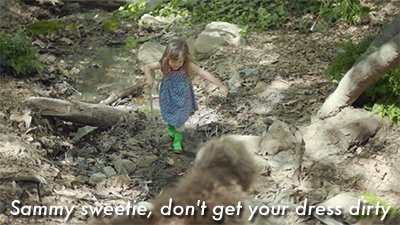




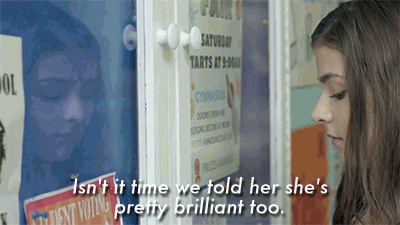
People have offered many potential explanations for this discrepancy, but this ad highlights the importance of the social cues that push girls away from math and science in their earliest childhood years.
Watch the powerful Verizon advertisement to really understand what a little girl hears when you tell her she’s pretty.

Oh my gosh this is incredibly exciting! Imagine combining them with a Star Wars LEGO set...

Did you know that when we classify stars, we’re comparing different types of stars but also stars at different stages of their life cycles? This is the second in a two-part episode about star classifications (go listen to Part 1 if you haven’t already; or listen to this one first and then listen to Part 1, it’s not exactly spoiler territory here). In this podcast, I talk about the various ways we've chosen to interpret observational data on stars, from observing the bright sky-dots to evaluating how bright they are by comparing them to each other, and all the new things we can do with new observational techniques. Never fear, Harvard observatory’s computers make a significant appearance again in this one!
I did my best to explain everything in as comprehensible terms as possible but you can hit me up with questions if you have them! I’m also on Twitter at @HDandtheVoid if you’d rather ask me there. And go ahead and check out the podcast on iTunes, rate it or review it if you’d like, and subscribe! I’ll always post all the extras here on tumblr but iTunes is probably more convenient for downloading.
Below the cut are my sources, music credits (thanks Elena for the filler music suggestion, very on-the-nose), vocab list, and the transcript. I mention a couple of books and quote a couple people in this episode so if you want to see that written down, those sources are there as well. Let me know what you think of this episode, let me know what you think I should research next*, tell me a fun space fact… anything’s helpful!
*(My thoughts were planets or looking into a couple major astronomers; either Edmond Halley or Tycho Brahe <3 or maybeStephen Hawking? Let me know by the 23rd so I can get a podcast up by July 3rd!)
Glossary:
Charge-Coupled Device (CCD) - a device that moves an electrical charge to shift the signal between incoming photons to turn them into electron charges that can then be read as an image. It’s used in digital cameras and in astronomy for UV-to-infrared applications.
deep-sky object - any cosmological object that isn’t individual stars or something from our Solar System. It’s a classification that includes nebulae, galaxies, and star clusters, and it has its roots in amateur astronomy.
Hipparcos satellite - the European Space Agency ‘high precision parallax collecting satellite’ that operated between 1989 and 1993. It gathered astronomical and photometric data of stars and was highly accurate in positioning and cataloging the star information it acquired on its four-year mission. Its data was published in 1997 in two catalogs: the Hipparcos Catalogue, distributed in print as well as on CDs and mapped 118,218 stars; and the Tycho Catalogue, distributed only on CDs and mapped 1,058,332 stars. The Tycho-2 Catalogue was an updated version of the Tycho Catalogue made with more refined imaging techniques and re-released on CDs and online in 2000 with over 2 million stars mapped.
neutron star - a type of star that has gone supernova, when the surviving core is 1.5 to 3 solar masses and contracts into a small, very dense, very fast-spinning star.
pulsar - a type of neutron stars that spins very, very fast: a kind of variable star that emits light pulses usually between 0.0014 seconds and 8.5 seconds.
stellar photometry/photometrics - measuring the brightness of stars and the changes of brightness over time. Previously used photographic plates and visual equipment in professional observatories, but shifted after an international photoelectric system was established in 1951. Currently we use photoelectric devices, such as CCDs.
stellar spectra classification - developed at Harvard Observatory in the 20th century, a categorization of stars based on stellar surface temperatures rather than actual compositional differences, gravity, or luminosity in stars. From highest temperature to lowest, the seven main stellar types are O, B, A, F, G, K, and M. O, B, and A type stars are often referred to as early spectral types, while cool stars like G, K, and M are known as late type stars, even though these titles are based in disproven ideas about stellar evolution.
Script/Transcript
Sources:
Standard stellar types via University of College London
List/timeline of major historical star catalogs
A brief history of early star catalogs, since the International Astronomical Union made a new star catalog in 2016.
A history of the Messier list
A history of the Messier List and how amateur astronomers use it
The Messier List
A really detailed Messier List, including Messier’s own observations on the object along with what it is currently understood to be
`Deep Sky Observers Companion online database
The Caldwell List via SEDS
The Caldwell List via the Astronomical League
Translation of ‘Durchmusterung’ via PONS online translation
Some hilarious mnemonics that are an alternative to the girl-kissing one to remember the order of stellar spectra. I don't know why there’s an entire page dedicated to this but good on you, Caltech.
Photometry overview via the Astronomical Society of South Australia
Hipparcos Catalog via NASA
History of the Hipparcos satellite and subsequent catalogs via ESA
Tycho-2 Catalog via NASA
The Hipparchos and Tycho catalogues online and downloadable if you have a whole lot of storage space to put them in
The U.S. Navy’s Naval Meteorology and Oceanography Command website has a list of recommended informational catalogs, last updated in November 2004
Information on current star charts, specialized and general, and how to download them
The Research Consortium on Nearby Stars’ website, working on cataloging and characterizing all stars within 10 parsecs/32.6 light years of Earth
The Smithsonian Astrophysical Observatory star catalog, which goes to V=9. Please don’t ask me how the hell it works, I didn’t bother ordering it
Another SAO catalog via NASA’s High Energy Astrophysics Science Archive Research Center website
If you can figure out how to navigate this catalog, you should probably take over this podcast for me.
Soba, Dava. The Glass Universe: How the Ladies of the Harvard Observatory Took the Measure of the Stars. Viking: New York, 2016.
“After all, astronomers could not yet tie any given traits of stars, such as temperature or age, to the various groupings of spectral lines. What they needed was a consistent classification—a holding pattern for the stars—that would facilitate fruitful future research” (91).
“A good number of other blank spaces in her tables pointed up other lacunae, such as missing minimum values, uncertain periods, absent spectra, or questionable variable type” (113).
Annie Jump Cannon: “Since I have done almost all the world’s work in this one branch, it was necessary for me to do most of the talking” (158)
Ogilvie, Marilyn Bailey. Women in Science: Antiquity Through the Nineteenth Century. MIT P: Cambridge, MA, 1986. Located in Google Books preview.
Mack, Pamela E. “Straying from Their Orbits: Women in Astronomy in America.” In Women of Science: Righting the Record. Ed. Gabriele Kass-Simon, Patricia Farnes, Deborah Nash. Indiana U P: Bloomington, IN, 1993 (72-116). Located in Google Books preview.
Selin, Helaine. “Battani” Encyclopaedia of the History of Science, Technology, and Medicine in Non-Western Cultures. Springer Science & Business Media: Berlin, Germany, 2011. Located in Google Books preview.
Intro Music: ‘Better Times Will Come’ by No Luck Club off their album Prosperity
Filler Music: ‘Champagne Supernova’ by Oasis off their album (What’s the Story) Morning Glory?
Outro Music: ‘Fields of Russia’ by Mutefish off their album On Draught

Spacewalk complete and new astronaut record set! Shane Kimbrough and Peggy Whitson of NASA successfully reconnected cables and electrical connections on an adapter-3 that will provide the pressurized interface between the station and the second of two international docking adapters to be delivered to the complex to support the dockings of U.S. commercial crew spacecraft in the future. The duo were also tasked with installing four thermal protection shields on the Tranquility module of the International Space Station.
Having completed her eighth spacewalk, Whitson now holds the record for the most spacewalks and accumulated time spacewalking by a female astronaut. Spacewalkers have now spent a total of 1,243 hours and 42 minutes outside the station during 199 spacewalks in support of assembly and maintenance of the orbiting laboratory.
Astronaut Thomas Pesquet of ESA posted this image and wrote, ’ Shane and Peggy on their way to their first #spacewalk tasks.’
Credit: ESA/NASA
Tampons were packed with their strings connecting them, like a strip of sausages, so they wouldn’t float away. Engineers asked Ride, “Is 100 the right number?” She would be in space for a week. “That would not be the right number,” she told them. At every turn, her difference was made clear to her. When it was announced Ride had been named to a space flight mission, her shuttle commander, Bob Crippen, who became a lifelong friend and colleague, introduced her as “undoubtedly the prettiest member of the crew.” At another press event, a reporter asked Ride how she would react to a problem on the shuttle: “Do you weep?”
Astronaut Sally Ride and the Burden of Being “The First” (via dinosaurparty)
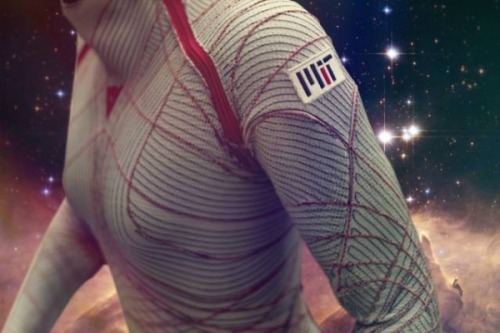
Next Generation Spacesuit like Second Skin
Scientists from MIT have designed a next-generation spacesuit that acts practically as a second skin, and could revolutionize the way future astronauts travel into space. (Photo : Jose-Luis Olivares/MIT)
Astronauts are used to climbing into conventional bulky, gas-pressurized spacesuits, but this new design could allow them to travel in style. Soon they may don a lightweight, skintight and stretchy garment lined with tiny, muscle-like coils. Essentially the new suit acts like a giant piece of shrink-wrap, in which the coils contract and tighten when plugged into a power supply, thereby creating a “second skin.”
“With conventional spacesuits, you’re essentially in a balloon of gas that’s providing you with the necessary one-third of an atmosphere [of pressure,] to keep you alive in the vacuum of space,” lead researcher Dava Newman, a professor of aeronautics and astronautics and engineering systems at MIT, said in astatement.
“We want to achieve that same pressurization, but through mechanical counterpressure - applying the pressure directly to the skin, thus avoiding the gas pressure altogether. We combine passive elastics with active materials. … Ultimately, the big advantage is mobility, and a very lightweight suit for planetary exploration.”
Newman, who has worked for the past decade on a design for the next-generation spacesuit, describes the new garment in detail in the journal IEEE/ASME: Transactions on Mechatronics.
The MIT BioSuit’s coils, which are a main feature of the outfit, are made from a shape-memory alloy (SMA). At a certain temperature, the material can “remember” and spring back to its engineered shape after being bent or misshapen.
Skintight suits are not a novel idea, but in the past scientists have always struggled with the question: how do you get in and out of a suit that is so tight? That’s where the SMAs come in, allowing the suit to contract only when heated, and subsequently stretched back to a looser shape when cooled.
Though the lightweight suit may not seem at first like it can withstand the harsh environment that is outer space, Newman and his colleagues are sure that the BioSuit would not only give astronauts much more freedom during planetary exploration, but it would also fully support these space explorers.
Newman and his team are not only working on how to keep the suit tight for long periods of time, but also believe their design could be applied to other attires, such as athletic wear or military uniforms.
“An integrated suit is exciting to think about to enhance human performance,” Newman added. “We’re trying to keep our astronauts alive, safe, and mobile, but these designs are not just for use in space.”
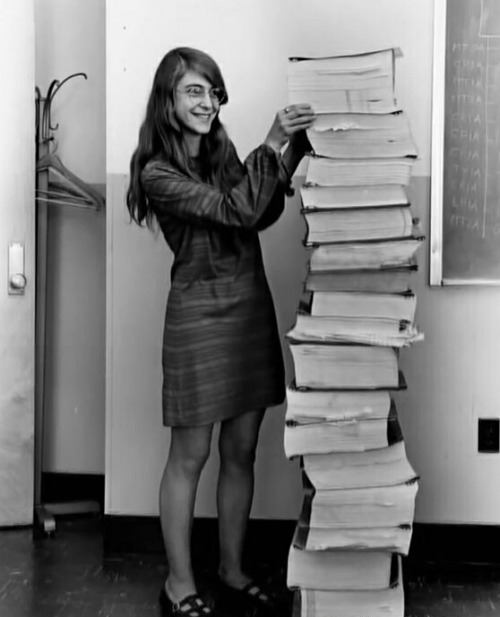
Margaret Hamilton is a computer scientist and mathematician. She was the lead software engineer for Project Apollo. Her work prevented an abort of the Apollo 11 moon landing. She’s also credited for coining the term “software engineer."
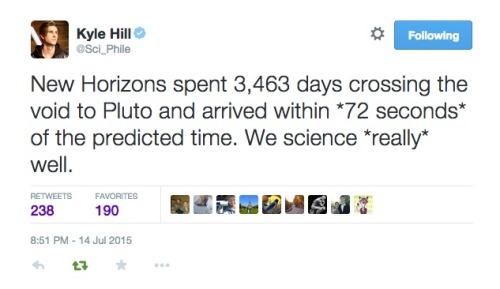
Its pretty incredible how accurate the science of astrophysics has gotten. New Horizons actually arrived 72 seconds early after travelling for almost 10 years straight to its destination.

Mission Specialist Mae Jemison, the first African American woman in space, during mission STS-47 .
via reddit
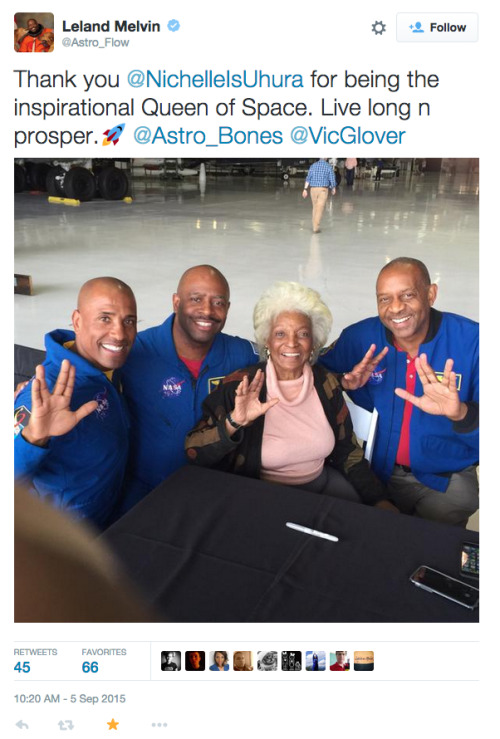
Why Star Trek matters.
Just a reminder that the first NASA astronauts were supposed to be women because generally they are smaller, lighter (less weight in the cockpit means less fuel required) and eat less than men and so would be easier to accommodate in space.
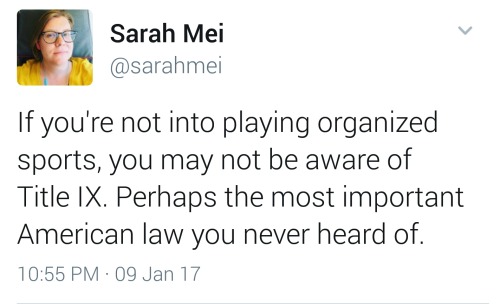
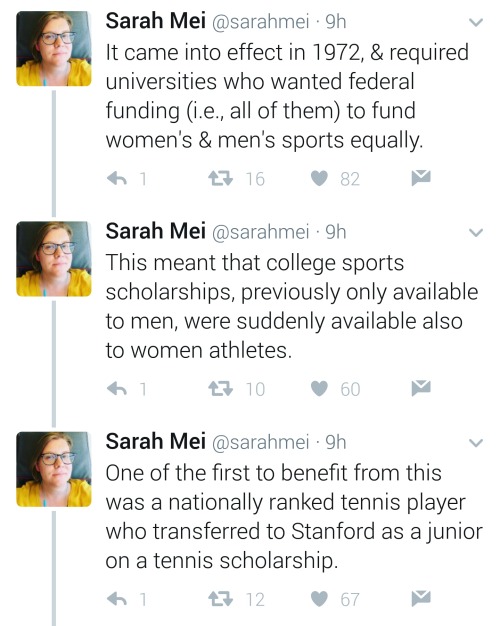
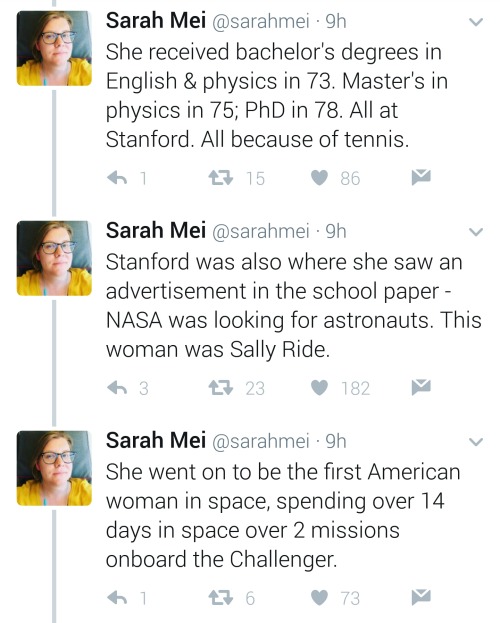
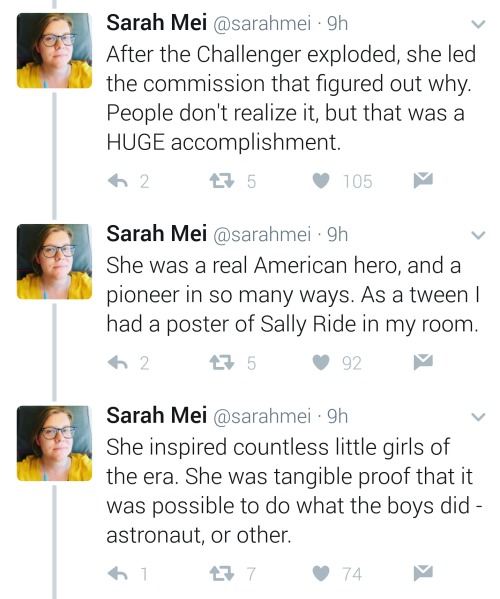
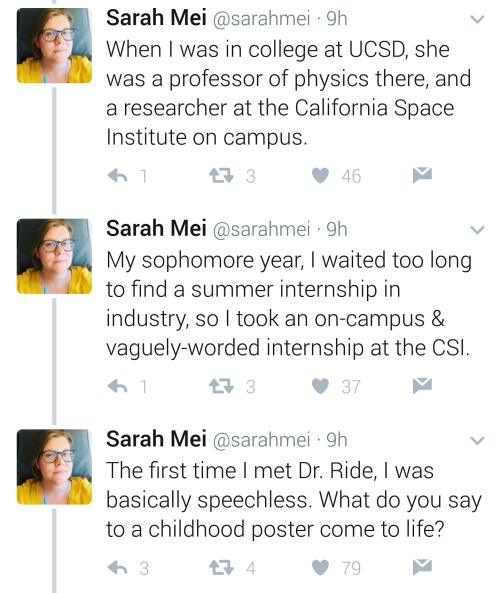
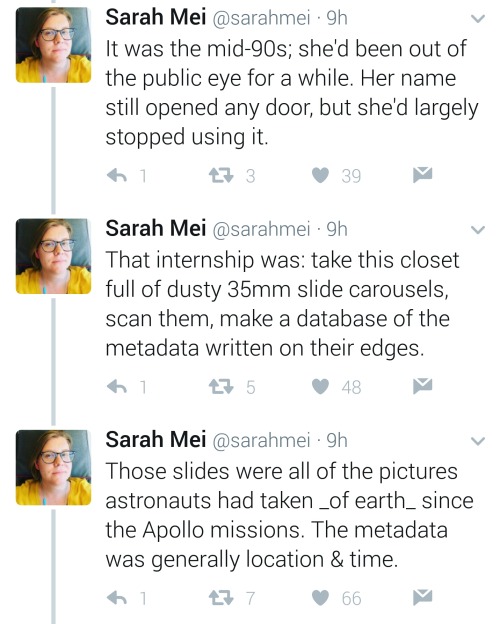
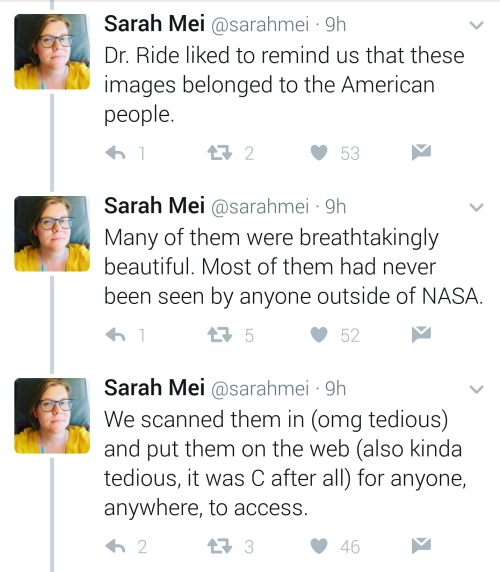
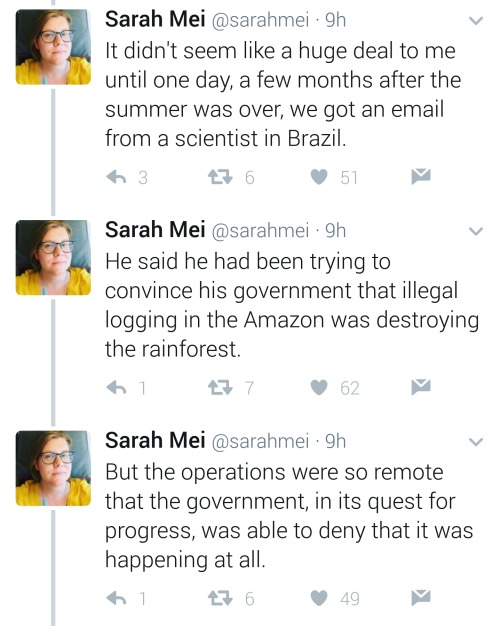
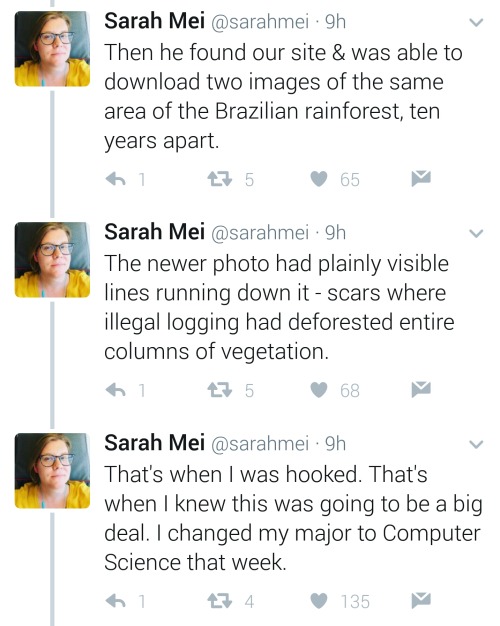
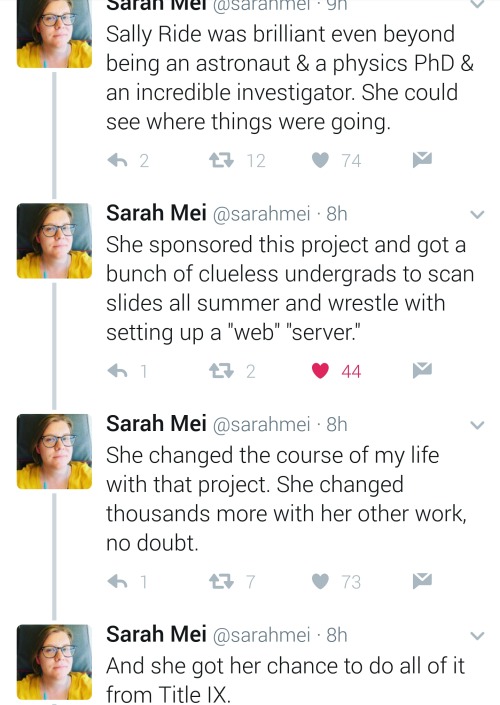
Equal opportunity benefits can be far-reaching
https://twitter.com/sarahmei/status/818682610712866817

First Female U.S. Astronaut, Sally Ride, Comes Out In Obituary | BuzzFeed
“I hope it makes it easier for kids growing up gay that they know that another one of their heroes was like them,” Sally Ride’s sister, Bear Ride, said.
Chanda Jog

Astrophysicist Chanda Jog was born on November 7, 1954 in India. Her research focuses on interstellar molecular clouds, evolution and dynamics of interacting galaxies, and theoretical problems in galactic dynamics. Jog works at the Indian Institute of Science, and serves as President of the National Committee for Astronomy in India. She is a fellow of the World Academy of Science, the Indian National Science Academy, and the Indian Academy of Sciences, as well as an active member of the International Astronomical Union.
Happy birthday, Chanda Jog!
Image credit: IAU Image License
Woman who loves science over here
Science Side of Tumblr, I need your help! Ladies of the Science Side of Tumblr, I especially need your help!
I had a conversation at my non-science day job that went like this:
A friend who shall be called Diane (not her real name) comes to my desk to chat. Just one of the many topics we discuss is that her boyfriend is taking a class in wildlife biology. She has decided that she has grown tired of hearing about local wildlife and hearing him recite a plethora of scientific names.
I responded positively to this subject, and told her that I too found the subject interesting. A third person had heard our conversation. We shall call her Claire (again, not her real name). Claire immediately responded, “Girls don’t like that kind of thing.”
“Are you saying that girls don’t like science?” I asked.
“No, not normally they don’t,” she responded.
Before you all screech with anguish, bear with me for a moment. We all know that this is not true. As a man, I find this idea upsetting for countless reasons that have all been validly discussed before. To try to debate the issue is rather moot. Instead, I’d like a show of hands.
Ladies of the Science Side of Tumblr! I call you to arms! Will you rally around me in saying that women can and do indeed love science, of any variety? Gentleman of the Science Side of Tumblr who know someone who is a girl who also happens to love science, will you stand with me too? We all like and reblog the pro-women-in-science posts we see so often, let’s all stand and be counted in one place this time.
Reblog this if you are a woman who loves science. Reblog this if you are a man who knows a woman who loves science. Let us disprove her beyond all doubt!
Scientific Women You Haven’t Heard of (Yet): Louise Pearce

Louise Pearce is best known for her work that lead to a cure for sleeping sickness. Pearce traveled to what is now the Democratic Republic of the Congo to test the arsenic based cure, tryparsamide, in cooperation with a hospital in Léopoldville that was coping with an outbreak of sleeping sickness. This trip helped establish parameters for treatment (such as safe and optimum dosages) of sleeping sickness with tryparsamide. Pearce also used rabbit colonies to study syphilis and cancer over generations. Pearce was lesbian and a feminist and lived with Sara Josephine Baker and Ida A.R. Wylie. Pearce’s curriculum vitae is impressive and lists Standford University, Boston University and Johns Hopkins University as her alma maters.
Learn more: (x) (x) (x)
Previous Installments: Lynn Conway, Noella Marcellino, Tu Youyou
About the series: (x)
i think i did something actually worthwhile in science this week.
i was asked to review a children’s science book for accuracy, and upon doing so i noted that every scientist mentioned by name was a man, and the vast majority were white. i pointed this out to the publishers in my review letter.
surprisingly, my comments seemed well received. i was thanked for noticing what everyone else had missed, and they told me they were going to change the list of scientists they discussed to be more representative. so, yay? i may have actually had a positive impact on science education?
what am i even doing still stuck at the bench, pipetting shit.

Hot off the presses! Check out the cover of my new book: Women In Science. Thanks to ten speed press for sending me a copy! Very proud and excited. Hits stores July 26 but you can pre-order it here: readwomeninscience.com
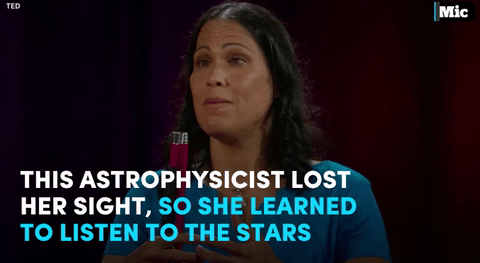

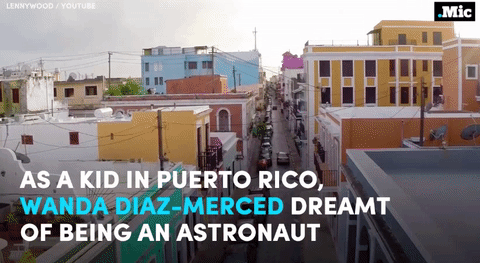

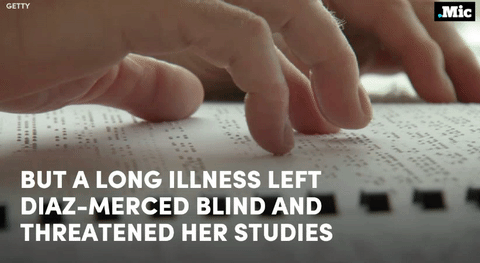

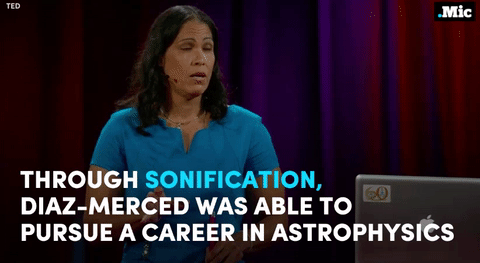




![Since her death in 1979, the woman who discovered what the universe is made of has not so much as received a memorial plaque. Her newspaper obituaries do not mention her greatest discovery. […] Every high school student knows that Isaac Newton discovered gravity, that Charles Darwin discovered evolution, and that Albert Einstein discovered the relativity of time. But when it comes to the composition of our universe, the textbooks simply say that the most abundant atom in the universe is hydrogen. And no one ever wonders how we know.❞ — Jeremy Knowles, discussing the complete lack of recognition Cecilia Payne gets, even today, for her revolutionary discovery. (via alliterate) OH WAIT LET ME TELL YOU ABOUT CECILIA PAYNE • Cecilia Payne’s mother refused to spend money on her college education, so she won a scholarship to Cambridge. • Cecilia Payne completed her studies, but Cambridge wouldn’t give her a degree because she was a woman, so she said to heck with that and moved to the United States to work at Harvard. • Cecilia Payne was the first person ever to earn a Ph.D. in astronomy from Radcliffe College, with what Otto Strauve called “the most brilliant Ph.D. thesis ever written in astronomy.” • Not only did Cecilia Payne discover what the universe is made of, she also discovered what the sun is made of (Henry Norris Russell, a fellow astronomer, is usually given credit for discovering that the sun’s composition is different from the Earth’s, but he came to his conclusions four years later than Payne — after telling her not to publish). • Cecilia Payne is the reason we know basically anything about variable stars (stars whose brightness as seen from earth fluctuates). Literally every other study on variable stars is based on her work. • Cecilia Payne was the first woman to be promoted to full professor from within Harvard, and is often credited with breaking the glass ceiling for women in the Harvard science department and in astronomy, as well as inspiring entire generations of women to take up science. • Cecilia Payne is awesome and everyone should know her. (OP: Matthew Gardner)](https://64.media.tumblr.com/62252d2e0b47b6782fbd6ef350407812/5bd09b4ca294947e-d3/s500x750/58ae690a544239d5a7cdf38d6193c1e114d908a1.jpg)


